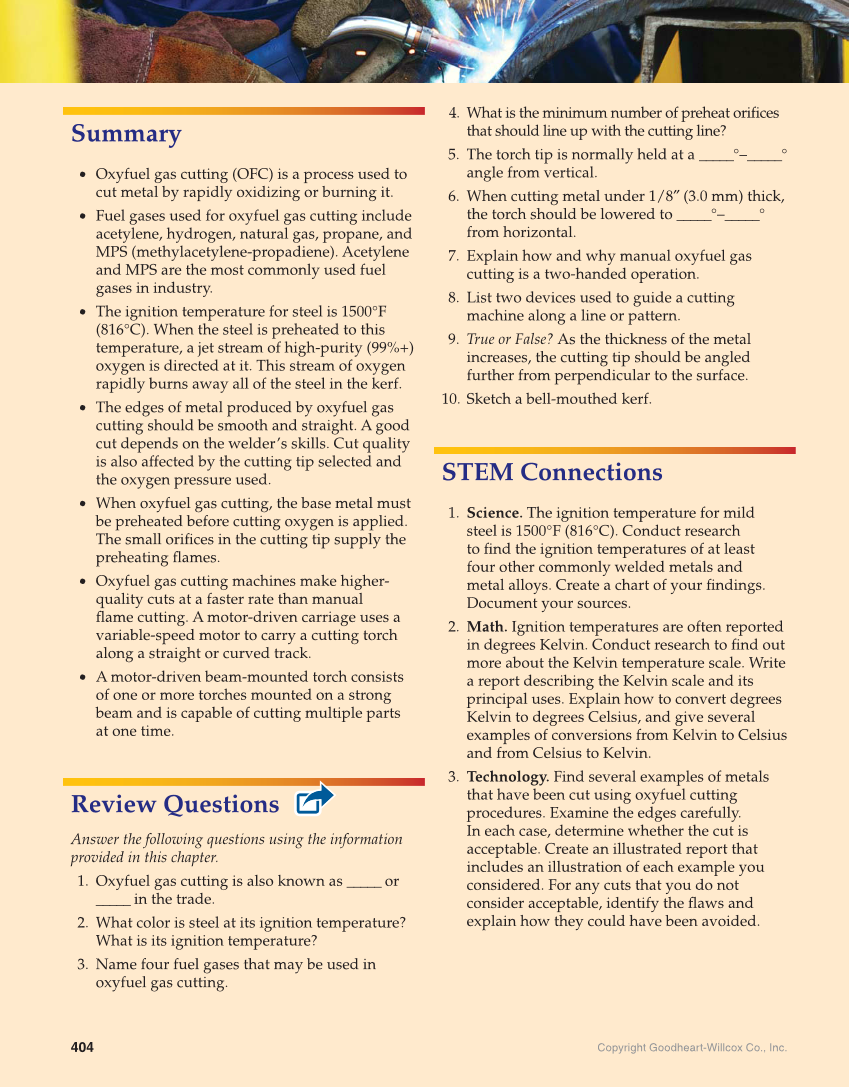Copyright Goodheart-Willcox Co., Inc. 404 Summary • Oxyfuel gas cutting (OFC) is a process used to cut metal by rapidly oxidizing or burning it. • Fuel gases used for oxyfuel gas cutting include acetylene, hydrogen, natural gas, propane, and MPS (methylacetylene-propadiene). Acetylene and MPS are the most commonly used fuel gases in industry. • The ignition temperature for steel is 1500°F (816°C). When the steel is preheated to this temperature, a jet stream of high-purity (99%+) oxygen is directed at it. This stream of oxygen rapidly burns away all of the steel in the kerf. • The edges of metal produced by oxyfuel gas cutting should be smooth and straight. A good cut depends on the welder’s skills. Cut quality is also affected by the cutting tip selected and the oxygen pressure used. • When oxyfuel gas cutting, the base metal must be preheated before cutting oxygen is applied. The small orifi ces in the cutting tip supply the preheating fl ames. • Oxyfuel gas cutting machines make higher- quality cuts at a faster rate than manual fl ame cutting. A motor-driven carriage uses a variable-speed motor to carry a cutting torch along a straight or curved track. • A motor-driven beam-mounted torch consists of one or more torches mounted on a strong beam and is capable of cutting multiple parts at one time. Review Questions Answer the following questions using the information provided in this chapter. 1. Oxyfuel gas cutting is also known as _____ or _____ in the trade. 2. What color is steel at its ignition temperature? What is its ignition temperature? 3. Name four fuel gases that may be used in oxyfuel gas cutting. 4. What is the minimum number of preheat orifi ces that should line up with the cutting line? 5. The torch tip is normally held at a _____°–_____° angle from vertical. 6. When cutting metal under 1/8″ (3.0 mm) thick, the torch should be lowered to _____°–_____° from horizontal. 7. Explain how and why manual oxyfuel gas cutting is a two-handed operation. 8. List two devices used to guide a cutting machine along a line or pattern. 9. True or False? As the thickness of the metal increases, the cutting tip should be angled further from perpendicular to the surface. 10. Sketch a bell-mouthed kerf. STEM Connections 1. Science. The ignition temperature for mild steel is 1500°F (816°C). Conduct research to fi nd the ignition temperatures of at least four other commonly welded metals and metal alloys. Create a chart of your fi ndings. Document your sources. 2. Math. Ignition temperatures are often reported in degrees Kelvin. Conduct research to fi nd out more about the Kelvin temperature scale. Write a report describing the Kelvin scale and its principal uses. Explain how to convert degrees Kelvin to degrees Celsius, and give several examples of conversions from Kelvin to Celsius and from Celsius to Kelvin. 3. Technology. Find several examples of metals that have been cut using oxyfuel cutting procedures. Examine the edges carefully. In each case, determine whether the cut is acceptable. Create an illustrated report that includes an illustration of each example you considered. For any cuts that you do not consider acceptable, identify the fl aws and explain how they could have been avoided.
